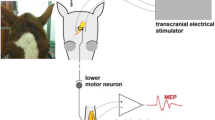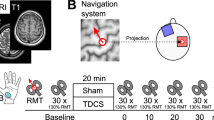Abstract
Motor potentials evoked by transcranial electrical stimulation (TES) are used for monitoring the motor pathways, with emphasis on the spinal cord and brainstem. The stimulus voltage threshold is the voltage below which no motor response can be elicited. It has frequently been used as a monitoring parameter. However, its value can be limited, because it is affected by the impedance of the stimulus electrode. For example, the voltage threshold can change owing to formation of oedema of the scalp. The relationship between the TES voltage threshold and the electrode impedance of different electrode types was studied and discussed in the context of neuromonitoring: 323 impedance and voltage threshold pairs were studied, and TES was performed with dics cup EEG electrodes (six), corkscrew electrodes (type I: seven, type II: eight), multiple EEG needle electrodes (16) and a large needle electrode Cz′ (anode) together with a ground strip over the forehead (cathode) (286). The study found the voltage threshold to be strongly dependent on electrode impedance when the impedance was higher than 460 Μ (correlation: R2=0.87; p<0.001). Below 460Ω, which included 91% of the category with the largest electrode surfaces, 25% of the multiple EEG electrodes and 75% of type II corkscrew electrodes, no significant correlation (R2=0.0064; p=0.15) was found. It was concluded that the correlation between the TES voltage threshold and electrode impedance can be markedly reduced by using TES electrodes with large contact surfaces, resulting in limit values for these parameters. This also may improve the reliability of TES motor evoked potential monitoring.
Similar content being viewed by others
References
Burke, D., Hicks, R., andStephen, J. (1992): ‘Anodal and cathodal stimulation of the upper-limb area of the human motor cortex’,Brain,115, pp. 1497–1508
Calancie, B., Harris, W., Broton, J. G., Alexeeva, N., andGreen, B. A. (1998): ‘‘Threshold-level’ multipulse transcranial electrical stimulation of motor cortex for intraoperative monitoring of spinal motor tracts: description of method and comparison to somatosensory evoked potential monitoring’,J. Neurosurg.,88, pp. 457–470
Calancie, B., Harris, W., Brindle, G. F., Green, B. A., andLandy, H. J. (2001): ‘Threshold-level repetitive transcranial electrical stimulation for intraoperative monitoring of central motor conduction’,J. Neurosurg.,95, pp. 161–168
Deletis, V., andCamargo, A. B. (2001): ‘Transcranial electrical motor evoked potential monitoring for brain tumor resection’,Neurosurgery,49, pp. 1488–1489
Foster, K. R., Schepps, J. L., Stoy, R. D., andSchwan, H. P. (1979): ‘Dielectric properties of brain tissue between 0.01 and 10 GHz’,Phys. Med. Biol.,24, pp. 1177–1187
Geddes, L. A., andBaker, L. E. (1967): ‘The specific resistance of biological material—a compendium of data for the biomedical engineer and physiologist’,Med. Biol. Eng.,5, pp. 271–293
Geddes, L. A. (1987): ‘Optimal stimulus duration for extracranial cortical stimulation’,Neurosurgery,20, pp. 94–99
Hicks, R. G., Woodforth, I. J., Crawford, M. R., Stephen, J. P., andBurke, D. J. (1992): ‘Some effects of isoflurane on I waves of the motor evoked potential’,Br. J. Anaesth.,69, pp. 130–136
Journee, H. L., Shils, J., Bueno de Camargo, A., Novak, K., andDeletis, V. (2003): ‘Failure of Digitimer's D-185 transcranial stimulator to deliver declared stimulus parameters’,Clin. Neurophysiol.,114, pp. 2497–2498
Kalkman, C. J., Ubags, L. H., Been, H. D., Swaan, A., andDrummond, J. C. (1995): ‘Improved amplitude of myogenic motor evoked responses after paired transcranial electrical stimulation during sufentanil/nitrous oxide anesthesia’,Anesthesiology,83 pp. 270–276
Kothbauer, K., Deletis, V., andEpstein, F. J. (1997): ‘Intraoperative spinal cord monitoring for intramedullary surgery: an essential adjunct’,Pediatr. Neurosurg.,26, pp. 247–254
McAdams, E. T., andJossinet, J. (1994): ‘Physical interpretation of Schwan's limit voltage of linearity’,Med. Biol. Eng. Comput.,32, pp. 126–130
Merton, P. A., andMorton, H. B. (1980): ‘Stimulation of the cerebral cortex in the intact human subject’,Nature,285, p. 227
Merton, P. A., Hill, D. K., Morton, H. B., andMarsden, C. D. (1982): ‘Scope of a technique for electrical stimulation of human brain, spinal cord, and muscle’,Lancet,2, pp. 597–600
Meylaerts, S. A., De-Haan, P., Kalkman, C. J., Lips, J., De-Mol, B. A., andJacobs, M. J. (1999): ‘The influence of regional spinal cord hypothermia on transcranial myogenic motor-evoked potential monitoring and the efficacy of spinal cord ischemia detection’,J. Thorac. Cardiovasc. Surg.,118, pp. 1038–1045
Pechstein, U., Cedzich, C., Nadstawek, J., andSchramm, J. (1996): ‘Transcranial high-frequency repetitive electrical stimulation for recording myogenic motor evoked potentials with the patient under general anesthesia’,Neurosurgery,39, pp. 335–343
Poletto, C. J., andVan Doren, C. L. (1999): ‘A high voltage, constant current stimulator for electrocutaneous stimulation through small electrodes’,IEEE Trans. Biomed. Eng.,46, pp. 929–936
Saha, S., andWilliams, P. A. (1995): ‘Comparison of the electrical and dielectric behavior of wet human cortical and cancellous bone tissue from the distal tibia’,J. Orthop. Res.,13, pp. 524–532
Stoy, R. D., Foster, K. R., andSchwan, H. P. (1982): ‘Dielectric properties of mammalian tissues from 0.1 to 100 MHz: a summary of recent data’,Phys. Med. Biol.,27, pp. 501–513
Ubags, L. H., Kalkman, C. J., Been, H. D., andDrummond, J. C. (1996): ‘The use of a circumferential cathode improves amplitude of intraoperative electrical transcranial myogenic motor evoked responses’,Anesth. Analg.,82, pp. 1011–1014
Ubags, L. H., Kalkman, C. J., Been, H. D., andDrummond, J. C. (1997): ‘Differential effects of nitrous oxide and propofol on myogenic transcranial motor evoked responses during sufentanil anaesthesia’,Br. J. Anaesth.,79, pp. 590–594
Van-Dongen, E. P., Ter-Beek, H. T., Schepens, M. A., Morshuis, W. J., Langemeijer, H. J., Kalkman, C. J., andBoezeman, E. H. (1999): ‘The influence of nitroux oxide to supplement fentanyl/low-dose propofol anesthesia on transcranial myogenic motor-evoked potentials during thoracic aortic surgery’,J. Cardiothorac. Vasc. Anesth.,13, pp. 30–34
Author information
Authors and Affiliations
Corresponding author
Rights and permissions
About this article
Cite this article
Journée, H.L., Polak, H.E. & de Kleuver, M. Influence of electrode impedance on threshold voltage for transcranial electrical stimulation in motor evoked potential monitoring. Med. Biol. Eng. Comput. 42, 557–561 (2004). https://doi.org/10.1007/BF02350999
Received:
Accepted:
Issue Date:
DOI: https://doi.org/10.1007/BF02350999




